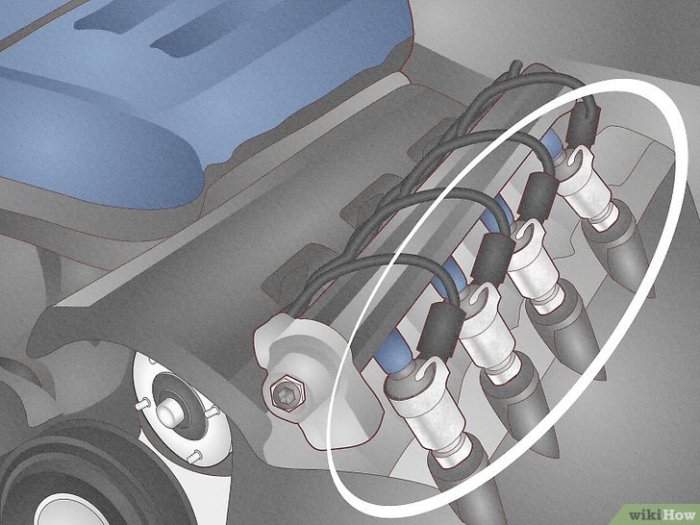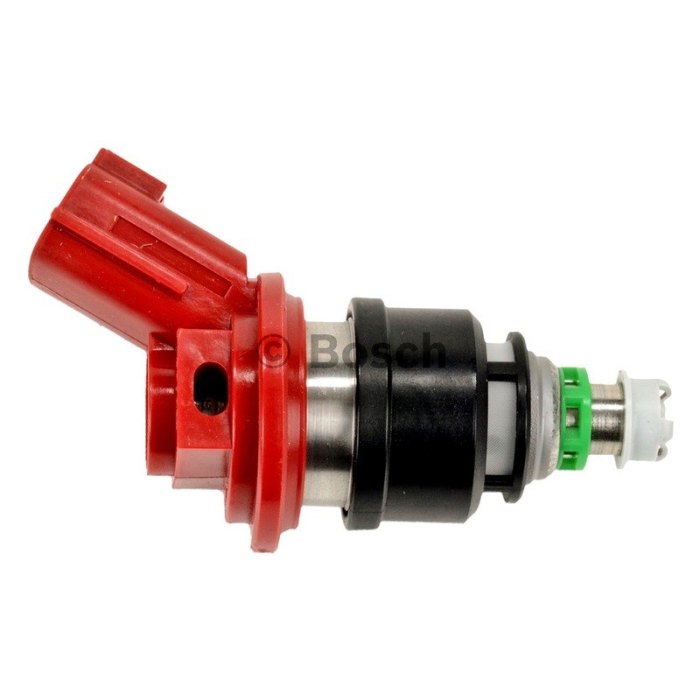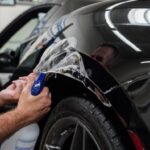Cost to replace a fuel injector? Yeah, that can be a real wallet-buster. This isn’t just about the price of the part itself; it’s a complex issue involving your car’s make and model, where you live (labor rates vary wildly!), and even your car’s age and mileage. We’ll break down all the factors influencing the cost, from DIY attempts to professional repairs, and even what your warranty might cover (or not!).
We’ll cover everything from recognizing the symptoms of a bad injector to understanding the different types of injectors and their price tags. Think of this as your ultimate guide to navigating the often confusing world of fuel injector replacement. Get ready to become a fuel-injection expert!
Factors Influencing Fuel Injector Replacement Cost

Getting a fuel injector replaced can be a surprisingly variable expense. Several factors combine to determine the final bill, making it difficult to give a single definitive price. Understanding these factors will help you better prepare for the cost.
Vehicle Make and Model
The make and model of your vehicle significantly impact the cost of fuel injector replacement. Luxury vehicles often use more sophisticated injectors and require specialized tools, leading to higher parts and labor costs. For instance, replacing an injector on a high-end German sedan will likely be more expensive than on a standard compact car due to the higher cost of the parts themselves and the potentially higher hourly labor rate charged by mechanics specializing in these vehicles.
Conversely, mass-produced vehicles tend to have readily available and more affordable parts, translating to lower overall costs.
Geographic Location and Labor Rates
Labor rates vary considerably depending on your location. Mechanics in major metropolitan areas, or those in areas with a high cost of living, typically charge higher hourly rates than those in smaller towns or rural areas. This difference directly affects the labor portion of your repair bill, which can represent a significant chunk of the total cost. For example, a simple injector replacement in a rural area might cost $500, while the same job in a major city could easily reach $800 or more, even with the same parts cost.
Parts Costs: Injectors and Related Components
The cost of the fuel injector itself is a major factor. OEM (Original Equipment Manufacturer) parts are usually more expensive than aftermarket alternatives, but they often offer better quality and reliability. However, the price difference can be substantial. Beyond the injector itself, other components might need replacement depending on the circumstances. For example, if a clogged injector caused damage to other parts of the fuel system, you might also need to replace fuel lines, fuel filters, or even other injectors.
These additional costs can quickly add up.
Vehicle Year and Mileage
Older vehicles and those with high mileage might require more extensive repairs during the injector replacement process. Years of wear and tear can make access to the injectors more difficult, increasing labor time and thus the cost. Furthermore, older vehicles might require specialized tools or techniques, again adding to the expense. High mileage might also suggest that other related components are nearing the end of their lifespan, potentially leading to additional repairs.
For example, a 10-year-old car with 200,000 miles might need additional work compared to a newer car with lower mileage.
Average Fuel Injector Replacement Costs by Vehicle Class
| Vehicle Class | Average Parts Cost | Average Labor Cost | Total Average Cost |
|---|---|---|---|
| Compact Car | $150 – $300 | $200 – $400 | $350 – $700 |
| Sedan | $200 – $400 | $250 – $500 | $450 – $900 |
| SUV | $250 – $500 | $300 – $600 | $550 – $1100 |
| Truck | $300 – $600 | $350 – $700 | $650 – $1300 |
DIY vs. Professional Repair
Replacing a fuel injector can be a significant undertaking, and the choice between DIY and professional repair hinges heavily on your mechanical aptitude, available tools, and risk tolerance. While DIY can potentially save money, it also carries risks that could end up costing more in the long run. Let’s break down the cost comparison and considerations.Choosing between tackling a fuel injector replacement yourself or entrusting it to a professional mechanic involves a careful assessment of your skills, resources, and comfort level with potentially complex automotive repairs.
A successful DIY job can lead to significant cost savings, but an unsuccessful attempt could result in additional expenses and potentially damage to your vehicle. This section details the costs, risks, and resources involved in both approaches.
Tools and Materials for DIY Fuel Injector Replacement
Before attempting a DIY fuel injector replacement, you’ll need a comprehensive set of tools and materials. Improper tools or a lack of essential supplies can significantly increase the difficulty and risk of the repair. This section provides a detailed list of necessary equipment.
Replacing a fuel injector can be a serious wallet-hitter, easily costing you several hundred bucks. That’s way more than something like changing your cabin air filter, which is a pretty straightforward DIY job. Check out this guide on the Cost to replace cabin air filter in Ford F-150 if you’re looking for a cheaper car maintenance task; then you can save up for that fuel injector repair.
- Socket set (metric and SAE): You’ll need a variety of sockets to remove and install various components.
- Wrench set (metric and SAE): Similar to the socket set, wrenches are crucial for loosening and tightening fasteners.
- Fuel line disconnect tools: These specialized tools prevent fuel spillage and damage to fuel lines during disconnection.
- Torque wrench: Essential for tightening bolts to the manufacturer’s specified torque, preventing damage to engine components.
- Fuel injector removal tool: These tools assist in safely removing and installing the injectors without damaging them.
- New fuel injectors: Purchase high-quality injectors that are compatible with your vehicle’s make, model, and engine.
- New fuel injector o-rings and seals: These are crucial for preventing fuel leaks.
- Clean rags and shop towels: For cleaning up fuel spills and keeping your workspace tidy.
- Fuel injector cleaner: To clean existing fuel injectors if you are only replacing some.
- Jack and jack stands: For safely lifting your vehicle and providing stable support during the repair.
- Owner’s manual: Essential for accessing specific repair instructions and torque specifications for your vehicle.
Potential Risks and Complications of DIY Fuel Injector Replacement
Undertaking a DIY fuel injector replacement presents several potential risks and complications. A lack of experience or improper techniques can lead to costly mistakes and further damage to your vehicle. This section Artikels some of the potential issues.
- Fuel leaks: Improper handling of fuel lines or damaged o-rings can lead to fuel leaks, posing a fire hazard.
- Damaged fuel injectors: Incorrect removal or installation can damage the new or existing fuel injectors.
- Engine damage: Incorrectly installed injectors can lead to misfires, reduced engine performance, or even catastrophic engine failure.
- Incorrect torque settings: Applying incorrect torque to bolts can strip threads or damage engine components.
- Difficulty accessing injectors: Depending on your vehicle’s design, accessing the fuel injectors can be challenging, requiring specialized tools or techniques.
Cost Comparison: DIY vs. Professional Repair
The following table provides a cost comparison between DIY and professional fuel injector replacement. Costs can vary significantly based on your location, vehicle, and the number of injectors needing replacement. These are estimates and may not reflect all scenarios.
| Cost Category | DIY | Professional Repair |
|---|---|---|
| Parts (fuel injectors, seals, etc.) | $200 – $800 (depending on vehicle and number of injectors) | $200 – $800 (same as DIY, but potentially higher quality parts) |
| Labor | $0 | $500 – $1500 (depending on location, shop, and vehicle) |
| Tools (if not already owned) | $100 – $500 | $0 |
| Potential Additional Expenses (e.g., towing, diagnostic fees) | Variable, potentially high if something goes wrong | Typically included in labor costs, unless a pre-existing issue is discovered |
| Total Estimated Cost | $300 – $1300 | $700 – $2300 |
Identifying the Need for Fuel Injector Replacement
So, your car’s acting up, and you suspect it might be a fuel injector issue. Before you start throwing money at the problem, it’s crucial to accurately diagnose the issue. Misdiagnosing can lead to unnecessary repairs and wasted cash. This section will help you identify the telltale signs of a failing fuel injector and guide you through the diagnostic process.Identifying a bad fuel injector requires a multi-pronged approach combining symptom recognition, diagnostic trouble code (DTC) interpretation, and a visual inspection.
Each step provides valuable clues, and combining these methods will give you the best chance of accurate diagnosis.
Common Symptoms of a Faulty Fuel Injector
A failing fuel injector doesn’t always announce itself with a dramatic bang. Often, the symptoms are subtle at first, gradually worsening over time. Recognizing these symptoms early can save you money and prevent more significant engine damage.
- Rough idling: The engine shakes or vibrates noticeably at idle. This is often a very early symptom.
- Hesitation or stumbling during acceleration: The engine feels sluggish or hesitates when you press the accelerator. This can range from mild to severe, impacting drivability significantly.
- Reduced fuel economy: You notice a significant drop in your gas mileage. For example, if you consistently got 25 mpg and now only get 18 mpg, this could be a strong indicator.
- Misfires: The engine misfires, causing a rough running condition and potentially triggering a check engine light. A misfire is often accompanied by a noticeable backfire or popping sound from the exhaust.
- Black smoke from the exhaust: Excessive black smoke indicates the engine is burning too much fuel, a potential sign of injector malfunction. The severity of the smoke can correlate with the extent of the problem.
- Engine stalling: In severe cases, a faulty injector can cause the engine to stall, especially at idle or during acceleration. This is a clear sign of a serious problem.
Interpreting Diagnostic Trouble Codes (DTCs)
Your car’s onboard diagnostic system (OBD-II) can provide valuable clues. A check engine light, often accompanied by a DTC, can pinpoint the problem. DTCs related to fuel injectors usually start with a “P” followed by a number. For example, codes like P0201, P0202, P0203, and P0204 typically indicate a problem with a specific fuel injector circuit (cylinder 1, 2, 3, and 4, respectively).
A mechanic will use a scan tool to retrieve and interpret these codes. It’s important to remember that a DTC only indicates a
So, you’re wondering about the cost to replace a fuel injector? That can range wildly depending on your car’s make and model. It’s a pretty significant repair, but honestly, sometimes it’s cheaper than dealing with major transmission issues; check out this article on how much does a transmission rebuild cost? to get a sense of the scale.
Ultimately, the cost to replace a fuel injector is something you’ll need to get a quote for from a mechanic.
potential* problem; further investigation is usually necessary for confirmation.
Visual Inspection of Fuel Injectors
While not always conclusive, a visual inspection can reveal obvious signs of damage. This step should be performed with the engine OFF and cool. Safety first!
- Locate the fuel injectors: Their location varies depending on the vehicle’s make and model. Consult your car’s repair manual for precise locations.
- Inspect for leaks: Look for any signs of fuel leakage around the injector seals or connections. Even a small leak can be problematic.
- Check for corrosion or damage: Examine the injectors for signs of corrosion, physical damage (dents, cracks), or excessive buildup of carbon deposits. Excessive carbon can impede proper fuel delivery.
- Examine the electrical connectors: Ensure the connectors are securely attached and free of corrosion or damage. Loose or corroded connectors can disrupt the electrical signal to the injector.
Types of Fuel Injectors and Their Cost Variations
Fuel injector replacement can be a significant expense, and the cost varies wildly depending on several factors, one of the most important being the type of injector itself. Understanding the different types and their associated costs is crucial for anyone facing this repair. This section will break down the various injector types, their price differences, and how the fuel system impacts the overall cost.Different fuel injector types exist, each with its own design, performance characteristics, and, consequently, price tag.
These differences stem from the injector’s location, spray pattern, and the overall fuel delivery system it’s part of. Brand reputation and quality also play a significant role in the cost.
Fuel Injector Types and Their Characteristics
Single-point fuel injection systems, a simpler design, use a single injector located in the intake manifold. This injects fuel into the air stream before it reaches the engine’s cylinders. Multi-point fuel injection, on the other hand, utilizes a separate injector for each cylinder, resulting in more precise fuel delivery. Direct injection systems, increasingly common in modern vehicles, inject fuel directly into the combustion chamber, leading to enhanced fuel efficiency and power.
These advancements, however, come with increased complexity and therefore higher costs. Diesel injectors are another category entirely, operating under much higher pressures and requiring specialized components, which contribute to a higher replacement cost compared to gasoline injectors.
Brand and Quality Differences, Cost to replace a fuel injector
The cost of fuel injectors varies significantly across brands. OEM (Original Equipment Manufacturer) parts, while generally more expensive, offer the best fit and reliability, often carrying a warranty. Aftermarket brands offer a range of options, from budget-friendly choices to high-performance alternatives. The quality and materials used in manufacturing impact both the price and the longevity of the injectors.
For example, a Bosch injector, a well-known and respected brand, typically commands a higher price than a lesser-known brand due to its reputation for quality and performance.
Fuel System Impact on Replacement Cost
The type of fuel system—gasoline, diesel, or alternative fuel—significantly impacts the replacement cost. Diesel injectors, as mentioned, are more complex and operate under much higher pressures than gasoline injectors. Their specialized design and materials make them considerably more expensive to replace. Alternative fuel systems, such as those used in hybrid or electric vehicles, often have unique injector designs and may involve even higher replacement costs due to their specialized nature and lower production volumes.
The labor cost also factors into this equation; a diesel injector replacement often takes longer and requires more specialized tools, thus increasing the overall repair bill.
Advantages and Disadvantages of Different Fuel Injector Types
The following table summarizes the advantages and disadvantages of different fuel injector types in terms of cost and performance.
| Fuel Injector Type | Advantages | Disadvantages |
|---|---|---|
| Single-Point | Simple design, low initial cost | Less precise fuel delivery, lower fuel efficiency compared to multi-point or direct injection |
| Multi-Point | Improved fuel efficiency and power compared to single-point, relatively lower cost than direct injection | More complex than single-point, higher cost than single-point |
| Direct Injection | Best fuel efficiency and power, improved emissions | Most complex design, highest initial cost, potential for higher repair costs due to complexity |
| Diesel Injectors | High power output, high torque | Highest cost, complex design, requires specialized tools and expertise for repair |
Warranty and Insurance Coverage: Cost To Replace A Fuel Injector

Fuel injector replacement can be a significant expense, so understanding your options for coverage is crucial. Both your vehicle’s warranty and your auto insurance policy might offer some protection, but the extent of coverage depends on several factors.Vehicle warranties often cover fuel injectors, but typically only for a limited time and under specific conditions. The specifics depend heavily on the manufacturer and the type of warranty (e.g., bumper-to-bumper, powertrain).
A powertrain warranty, for example, might include fuel injectors as part of the engine’s components, while a bumper-to-bumper warranty may have a shorter duration. It’s vital to thoroughly review your warranty documentation to understand the terms and conditions regarding fuel injector coverage. Pre-existing conditions, improper maintenance, or damage resulting from neglect or misuse are often grounds for exclusion.
Warranty Coverage Details
Understanding your vehicle’s warranty is the first step. The warranty booklet provided with your vehicle, or available on the manufacturer’s website, should clearly Artikel what components are covered, the duration of coverage, and any limitations or exclusions. For instance, a warranty might cover a faulty injector due to a manufacturing defect but not one damaged by contaminated fuel.
If you suspect a warranty claim is valid, contact your dealership or the manufacturer’s customer service immediately to initiate the process. They will likely require documentation such as proof of purchase, maintenance records, and potentially a diagnostic report from a qualified mechanic.
Insurance Claim Process for Fuel Injector Repair
Filing an insurance claim for fuel injector repair is similar to filing a claim for other car repairs. You’ll typically need to contact your insurance provider, report the damage, and provide necessary documentation, such as repair estimates from a qualified mechanic and potentially a police report if the damage resulted from an accident. The insurance company will then review your claim, potentially requiring an inspection of the vehicle before approving coverage.
The payout depends on your insurance policy’s coverage limits and deductible. Remember, insurance usually only covers repairs resulting from unforeseen events like accidents or sudden component failure, not routine wear and tear.
Factors Affecting Insurance Coverage
Several factors can influence whether your insurance covers fuel injector replacement. Your policy’s comprehensive coverage is usually required; liability coverage generally won’t cover this type of repair. The cause of the failure is another critical factor. If the failure is due to a sudden event like a collision, coverage is more likely. However, if the failure is due to normal wear and tear or lack of maintenance, your claim might be denied.
The age and condition of your vehicle can also impact coverage; older vehicles are less likely to have comprehensive coverage on parts that are considered wear items. Finally, the repair shop’s credentials and the reasonableness of the repair cost will be assessed by the insurance company.
Examples of Non-Coverage Scenarios
There are many scenarios where your warranty or insurance may not cover fuel injector replacement. For example, if your fuel injectors fail due to using low-quality fuel or neglecting regular maintenance, the warranty or insurance company might deny coverage. Similarly, if the damage is a result of a modification to the vehicle’s fuel system, this would likely void any warranty and not be covered by insurance.
Another example could be if the failure occurs after the warranty period expires. Finally, if the vehicle was subjected to extreme conditions (such as off-roading beyond the manufacturer’s recommendations) that contributed to the failure, it could lead to denial of a claim.
Preventive Maintenance to Extend Fuel Injector Lifespan
Keeping your fuel injectors in top shape isn’t just about avoiding costly repairs; it’s about ensuring your engine runs smoothly and efficiently. Regular preventative maintenance can significantly extend the lifespan of your fuel injectors, saving you money in the long run and preventing unexpected breakdowns. This involves a combination of smart fuel choices, routine cleaning, and mindful driving habits.Proper preventative maintenance is key to maximizing the lifespan of your fuel injectors and avoiding premature failure.
Neglecting this can lead to decreased fuel efficiency, rough idling, and ultimately, the need for expensive replacements. By implementing a few simple strategies, you can significantly reduce the risk of injector problems and keep your vehicle running smoothly for years to come.
High-Quality Fuel and its Impact on Fuel Injectors
Using high-quality fuel is paramount to maintaining your fuel injectors. Lower-grade fuels often contain higher levels of impurities and contaminants, which can clog the tiny nozzles within the injectors. This buildup can restrict fuel flow, leading to poor engine performance and eventual injector failure. Premium fuels, while more expensive, typically contain detergents that help keep the fuel system clean, minimizing the accumulation of deposits.
The long-term cost savings from preventing injector damage often outweigh the slightly higher upfront cost of premium fuel, especially considering the expense of a fuel injector replacement. For instance, using premium fuel in a vehicle that consistently runs on lower-grade fuel could potentially delay the need for injector cleaning or replacement by several years, easily offsetting the extra fuel cost.
Regular Fuel System Cleaning
Regular fuel system cleaning is another crucial aspect of preventative maintenance. Over time, deposits and varnish build up within the fuel system, impacting the injectors’ ability to deliver fuel precisely. Professional fuel system cleaning services utilize specialized equipment and cleaning solutions to flush out these contaminants, restoring optimal fuel flow and injector performance. While the cost of professional cleaning is a factor, it’s a significantly less expensive alternative to replacing fuel injectors.
Consider it an investment in preventative care; think of it as a routine checkup for your car’s circulatory system, preventing more serious, costly problems down the line. The frequency of professional cleaning will depend on factors like the type of fuel used and driving conditions, but a good rule of thumb is to have it done every 2-3 years or as recommended in your vehicle’s owner’s manual.
Long-Term Cost Savings Through Preventative Maintenance
The long-term cost savings associated with preventative maintenance are substantial. While the initial investment in high-quality fuel and periodic fuel system cleaning might seem higher upfront, it’s a small price to pay compared to the expense of replacing one or more fuel injectors. A single fuel injector replacement can cost hundreds of dollars, and the labor involved can further increase the overall cost.
By prioritizing preventative maintenance, you significantly reduce the likelihood of needing these costly repairs, leading to substantial savings over the vehicle’s lifespan. Think of it as an insurance policy for your engine; a small, regular premium prevents a much larger, unexpected payout later.
Summary
So, replacing a fuel injector can range from a DIY weekend project (with potential headaches) to a hefty bill at the mechanic. The key takeaway? Understanding the factors that influence the cost – from the type of injector to your location and whether you tackle the job yourself – is crucial. Armed with this knowledge, you can make informed decisions and avoid any nasty surprises.
Happy driving (and wrenching!)









